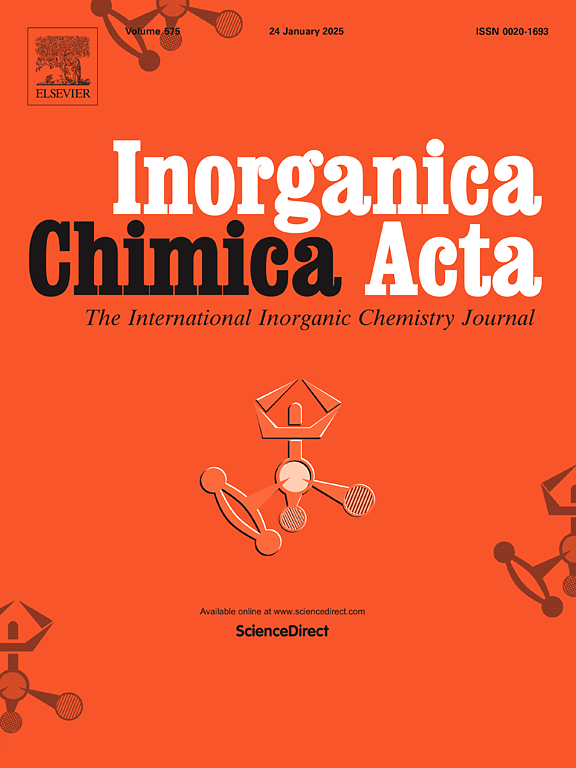2-(1h -咪唑-2-基)苯胺配体及其钴配合物:邻氨基酚的合成、表征、抗菌活性和氧化偶联
IF 3.2
3区 化学
Q2 CHEMISTRY, INORGANIC & NUCLEAR
引用次数: 0
摘要
我们报道了一个由2-(1h -咪唑-2-基)苯胺支架与水杨醛(HL1, HL3 - HL5)缩合得到的咪唑基希夫碱家族(HL1 = (E)-2-((2-(4,5-二苯基- 1h -咪唑-2-基)苯基)亚胺)甲基)苯酚;HL3 = (E)-2-((2-(4,5-双(4-甲氧基苯基)- 1h -咪唑-2-基)苯基)亚氨基)甲基)苯酚;HL4 = (E)-2-((2-(4,5-双(4-甲氧基苯基)-1-甲基- 1h -咪唑-2-基)苯基)亚氨基)甲基)苯酚;HL5 = (E)-2-((2-(1,4,5-三苯基- 1h -咪唑-2-基)苯基)亚氨基)甲基)苯酚}和2-吡啶甲醛(L2 = (E)-2-(4,5-二苯基- 1h -咪唑-2-基)- n-(吡啶-2-基亚甲基)苯胺)及其同眠剂CoII (1,2 - 7) {1 = [CoL1Cl]0.75H2O.0.5MeOH;2 = [CoL1(OAc)]0.75H2O;3 = [CoL2Cl2];4 = [CoL3Cl]1.5MeOH;5 = [CoL3(OAc)];6 = [CoL4Cl];7 = [CoL5Cl]}和CoIII (1v = [Co(L1)2]Cl.MeOH)配合物。通过元素分析、NMR、MS、FT-IR、电子吸收、磁化率和单晶x射线(1v、3,7和Co(IA4)Cl2)分析确定了化合物的配方。在亚胺配合物中,中性配体(3)的CoN键长度比阴离子配体(1v和7)长,表明3和7的高自旋(HS)状态(Co-N >;2.0 Å)和1v低自旋(LS)态(Co-N <;2.0)。该化合物对革兰氏(+)和革兰氏(−)细菌的活性测试表明,其活性优于使用的一种对照(特别是在平克雷恩氏杆菌和弗氏胞杆菌的情况下)。配合物的催化效率取决于部署的反离子的性质,分子支架和几何形状的细微变化。本文章由计算机程序翻译,如有差异,请以英文原文为准。

2-(1H-imidazol-2-yl)aniline bearing ligands and their cobalt complexes: Synthesis, characterisation, antimicrobial activity and oxidative coupling of o-aminophenol
We report a family of imidazole based Schiff bases obtained by condensation of 2-(1H-imidazol-2-yl)aniline scaffolds with salicylaldehyde (HL1, HL3 – HL5) {HL1 = (E)-2-(((2-(4,5-diphenyl-1H-imidazol-2-yl)phenyl)imino)methyl)phenol; HL3 = (E)-2-(((2-(4,5-bis(4-methoxyphenyl)-1H-imidazol-2-yl)phenyl)imino)methyl)phenol; HL4 = (E)-2-(((2-(4,5-bis(4-methoxyphenyl)-1-methyl-1H-imidazol-2-yl)phenyl)imino)methyl)phenol; HL5 = (E)-2-(((2-(1,4,5-triphenyl-1H-imidazol-2-yl)phenyl)imino)methyl)phenol} and 2-pyridinecarboxaldehyde (L2 = (E)-2-(4,5-diphenyl-1H-imidazol-2-yl)-N-(pyridin-2-ylmethylene)aniline), as well as their homoleptic CoII (1, 2–7) {1 = [CoL1Cl]0.75H2O.0.5MeOH; 2 = [CoL1(OAc)]0.75H2O; 3 = [CoL2Cl2]; 4 = [CoL3Cl]1.5MeOH; 5 = [CoL3(OAc)]; 6 = [CoL4Cl]; 7 = [CoL5Cl]} and CoIII (1v = [Co(L1)2]Cl.MeOH) complexes. The formulation of prepared compounds was determined by elemental analysis, NMR, MS, FT-IR, electronic absorption, magnetic susceptibility and single crystal X-ray analysis (1v, 3, 7 and Co(IA4)Cl2). In the imine complexes, the Co![]() N bond lengths are longer in the neutral ligand (3) than in the anionic ligands (1v and 7) and suggests high spin (HS) state in 3 and 7 (Co-N > 2.0 Å) and low spin (LS) state in 1v (Co-N < 2.0 Å). The compounds were tested against Gram (+) and Gram (−) bacteria and exhibited better activity than one of the control used (especially in the case of K. pne and C. freundii). The catalytic efficiency of the complexes depends on the nature of the counter ion deployed, subtle changes in the molecular scaffolds and geometry.
N bond lengths are longer in the neutral ligand (3) than in the anionic ligands (1v and 7) and suggests high spin (HS) state in 3 and 7 (Co-N > 2.0 Å) and low spin (LS) state in 1v (Co-N < 2.0 Å). The compounds were tested against Gram (+) and Gram (−) bacteria and exhibited better activity than one of the control used (especially in the case of K. pne and C. freundii). The catalytic efficiency of the complexes depends on the nature of the counter ion deployed, subtle changes in the molecular scaffolds and geometry.
求助全文
通过发布文献求助,成功后即可免费获取论文全文。
去求助
来源期刊

Inorganica Chimica Acta
化学-无机化学与核化学
CiteScore
6.00
自引率
3.60%
发文量
440
审稿时长
35 days
期刊介绍:
Inorganica Chimica Acta is an established international forum for all aspects of advanced Inorganic Chemistry. Original papers of high scientific level and interest are published in the form of Articles and Reviews.
Topics covered include:
• chemistry of the main group elements and the d- and f-block metals, including the synthesis, characterization and reactivity of coordination, organometallic, biomimetic, supramolecular coordination compounds, including associated computational studies;
• synthesis, physico-chemical properties, applications of molecule-based nano-scaled clusters and nanomaterials designed using the principles of coordination chemistry, as well as coordination polymers (CPs), metal-organic frameworks (MOFs), metal-organic polyhedra (MPOs);
• reaction mechanisms and physico-chemical investigations computational studies of metalloenzymes and their models;
• applications of inorganic compounds, metallodrugs and molecule-based materials.
Papers composed primarily of structural reports will typically not be considered for publication.
 求助内容:
求助内容: 应助结果提醒方式:
应助结果提醒方式:


